belt CADILLAC FLEETWOOD 1993 2.G Owners Manual
[x] Cancel search | Manufacturer: CADILLAC, Model Year: 1993, Model line: FLEETWOOD, Model: CADILLAC FLEETWOOD 1993 2.GPages: 386, PDF Size: 19.17 MB
Page 13 of 386

Downloaded from www.Manualslib.com manuals search engine r.
r !
r
This Cadillac Mpnual is divided into major sections.
Introduction - How to use this M,anual. .......... ..........
This section tells you how to use your Manual and includes
Safety and Vehicle Damage Warnings and Symbols I ~
Section 1 - Seats and Safety Belts .........................
This section tells you how to use your seats and safety
belts properly.
.--
Section 2 - Features and Controls .................. .A .... 63 :q
Section 3 - Comfort Controls and Audio Systems .......... 138.4
3 This section explains how to start and operate your Cadillac.
c
This section tells you how to adjust the ventilation and
comfort controls and how to operate your Sound System.
section 4 - Your Driving and the Road ................... 157
,. . Here you’ll. find helpful information and tips about the: ..
road and how to drive under different conditions.
Section 5 - Problems on the Road ....................... 216 4
This section tells you what to do if you have a problem
while driving, such as a flat tire, or engine overheating. ,
I
Section16 - Service and Appearance Care .................
Here the manual tells you how to keep your Cadillac !
running properly and looking good.
For more information on CCReporting Safety Defects”, .see Owner
Assistance, Page 6.
Page 17 of 386
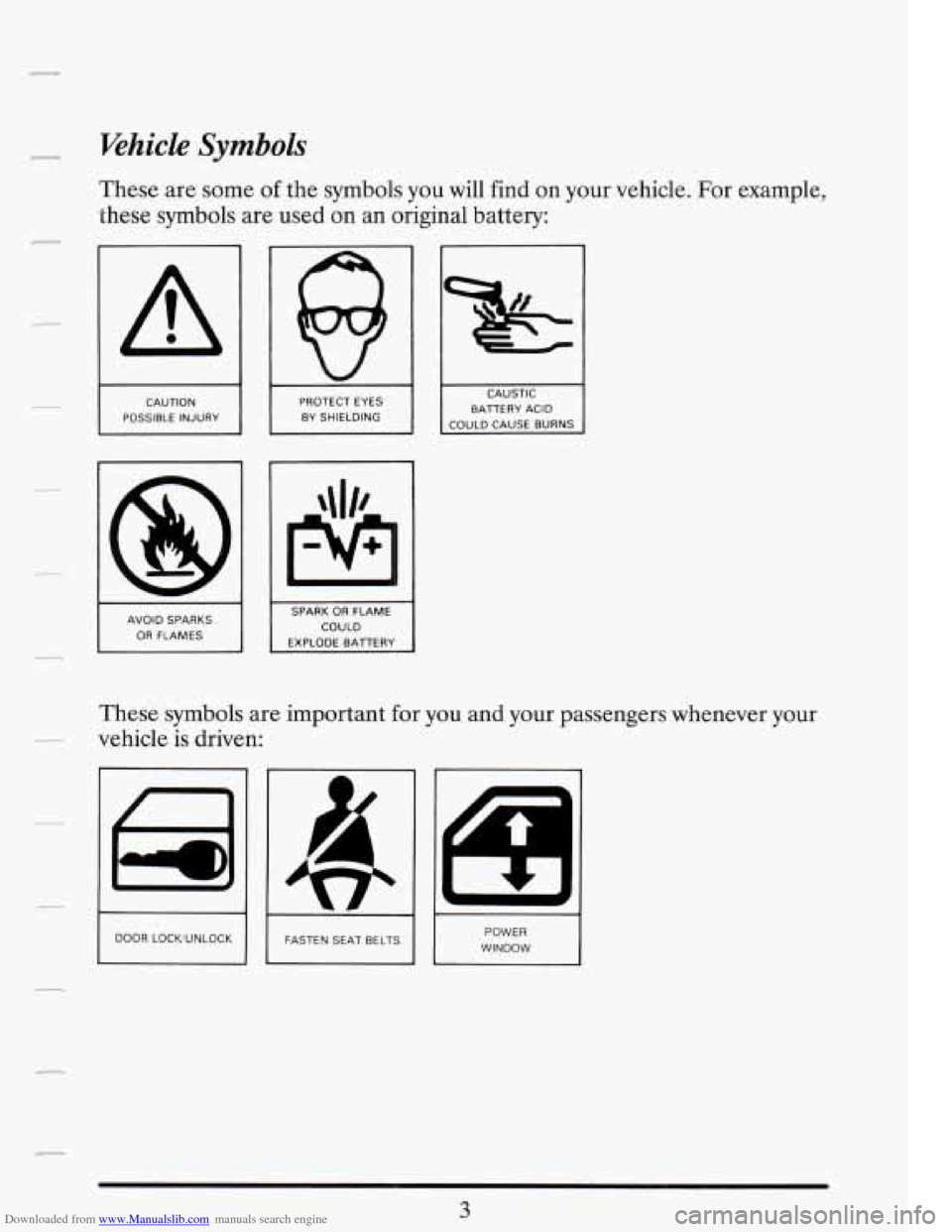
Downloaded from www.Manualslib.com manuals search engine c-
Ehicle Symbols
These are some of the symbols you will find on your vehicle. For example,
these
symbols are used on an original battery:
A
CAUTION
POSSIBLE INJURY
I
AVOID SPARKS OR FLAMES
m PROTECT EYES
BY SHIELDING
COULD EATERY
ACID
I llC3C 3yllluul3 illG llllyul lillll lU1
vehicle is driven:
1
DOOR LOCK'UNLOCK I I FASTEN SEAT BELTS I I I
POWER WINDOW
3
Page 20 of 386
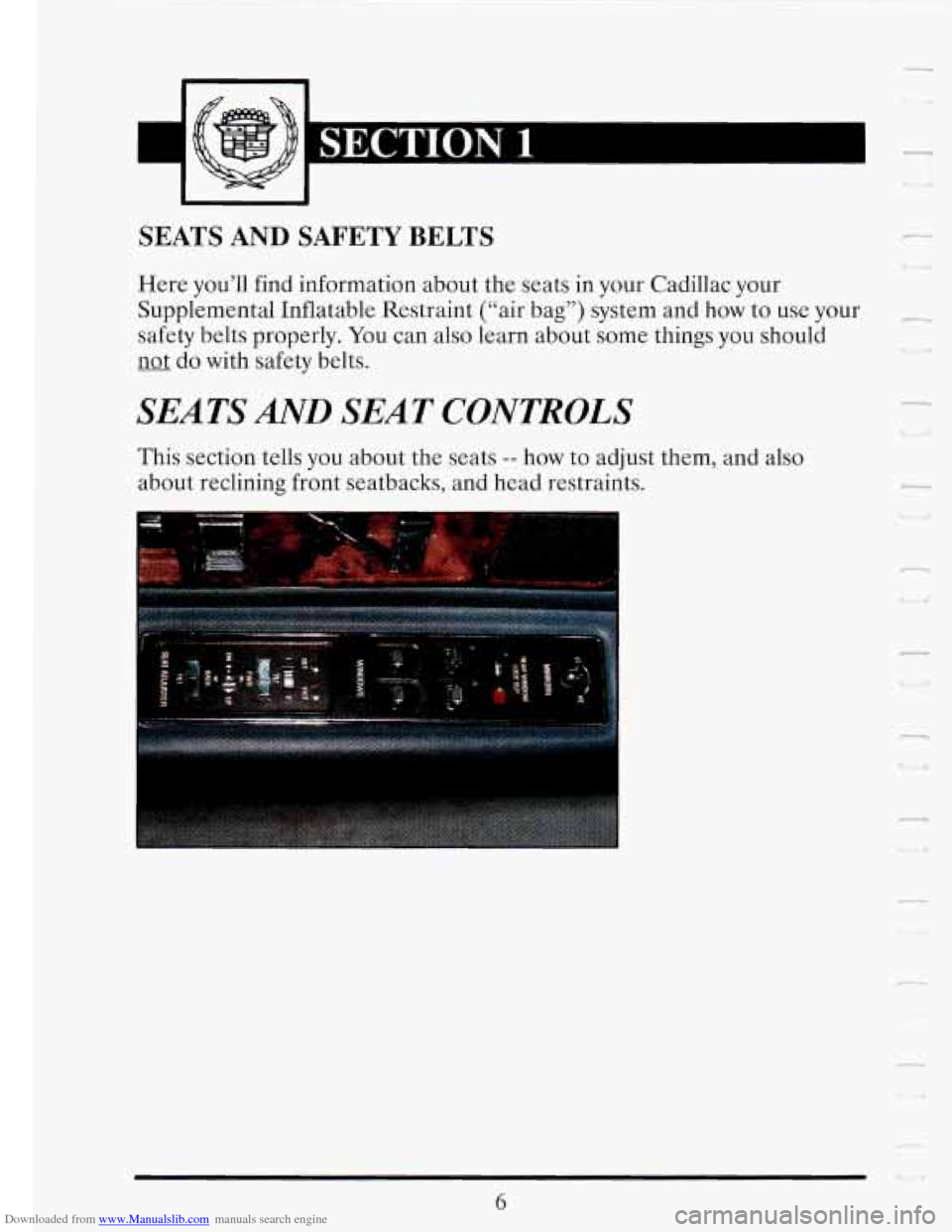
Downloaded from www.Manualslib.com manuals search engine I
1 SECTION 1
I
SEATS AND SAFETY BELTS
Here you’ll find information about the seats in your Cadillac your
Supplemental Inflatable Restraint (“air bag”) system and how to use your
safety belts properly.
You can also learn about some things you should
not do with safety belts.
SEATS AND SEAT CONTROLS
This section tells you about the seats -- how to adjust them, and also
about reclining front seatbacks, and head restraints.
I d
I
n
r.
6
Page 23 of 386
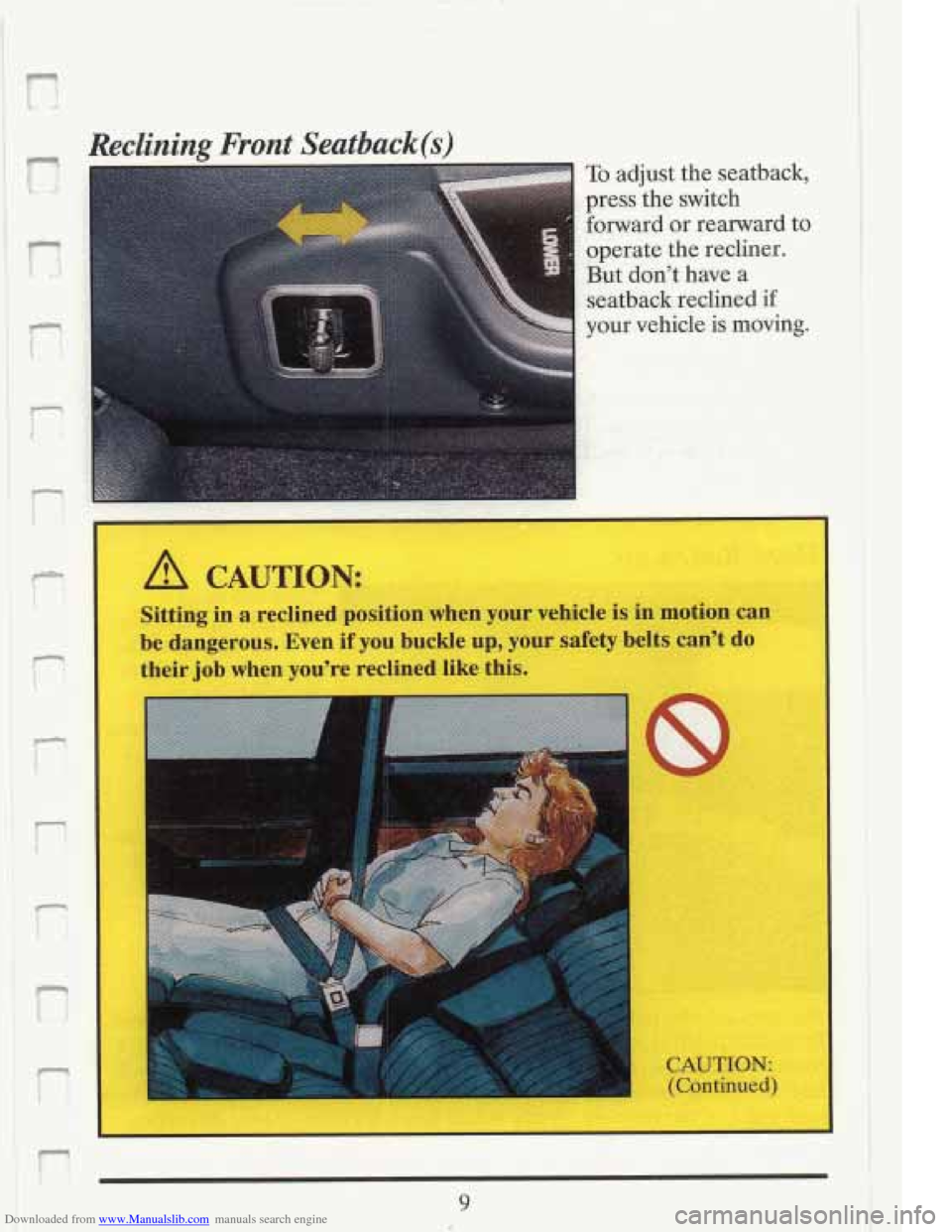
Downloaded from www.Manualslib.com manuals search engine P
n
ra
Reclining Front Seatback(s)
To adjust the seatback,
qress the switch
orward or rearward to
dperate the recliner.
But don't have a
seatback reclined if
your vehicle is moving.
I
their job when you're reclined like this.
A CAUTION:
Sitting in a reclined PO when your vehicle is in motion can
be dangerous. Even if you buckle up, your safety belts can't do
9
r
CAUTION:
(Continued)
I
Page 24 of 386

Downloaded from www.Manualslib.com manuals search engine I Ct TION: (I ~ ~ ntinued)
The shoulder belt can’t do its job because it won’t be against
your body. Instead, it will be in front
of you. In a crash you could
go into it, receiving neck or other injuries.
The lap belt can’t do its job either. In
a crash the belt could go
up over your abdomen. The belt forces would be there, not at
your pelvic bones. This could cause serious internal injuries.
For proper protection when the vehicle is in motion, have the
seatback upright. Then sit well back in the driver’s seat while
the car is moving. The seatback could jerk and cause
a loss of
control.
Head Restraints
I
I
L
I
1 Slide the head
restraint up or down
so that the top of the
restraint is closest to
the top
of your ears.
This position reduces
the chance of a neck
injury in a crash.
If you have the
Fleetwood Brougham
you have additional
adjustment to your
head restraint.
To
make these
adjustments, hold
both sides of
F
d
the restraint and pull it forward until you reach the forward most position.
From this position, firmly pull it forward. From this position, firmly pull it
forward again until
it releases. Slowly move the restraint forward (you will -
hear a clicking sound) until you reach a comfortable position. Now, holding a.
both sides of the restraint, gently rotate it in a forward or rear direction.
-
i
10
Page 26 of 386

Downloaded from www.Manualslib.com manuals search engine SAFLlTYBELTS: THEY’RE FOR EVERYONE
This part of the manual tells you how to use safety belts properly. It also
tells you some things you should not
do with safety belts.
And it explains the Supplemental Inflatable Restraint, or “air
bag”
system.
A CAUTION:
Don’t let anyone ride where they can’t wear a safety belt
properly.
If you are in a crash and you’re not wearing a safety
belt, your injuries can be much worse.
You can hit things inside
the vehicle or be ejected from it.
You can be seriously injured or
killed. In the same crash, you might not be if you are buckled
up. Always fasten your safety belt, and check that your
passengers’ belts are fastened properly too.
1’1
-!
L
This figure lights up when you turn the key to “Run” or “Start” when
your safety belt isn’t buckled, and you’ll hear a chime, too. It’s the
reminder to buckle up.
In many states and Canadian provinces, the law says to wear safety belts.
Here’s why: They work.
You never know if you’ll be in a crash. If you do have a crash, you don’t
know if it will be a bad one.
I
n
*-
r
4’
c_
\:
12
Page 27 of 386
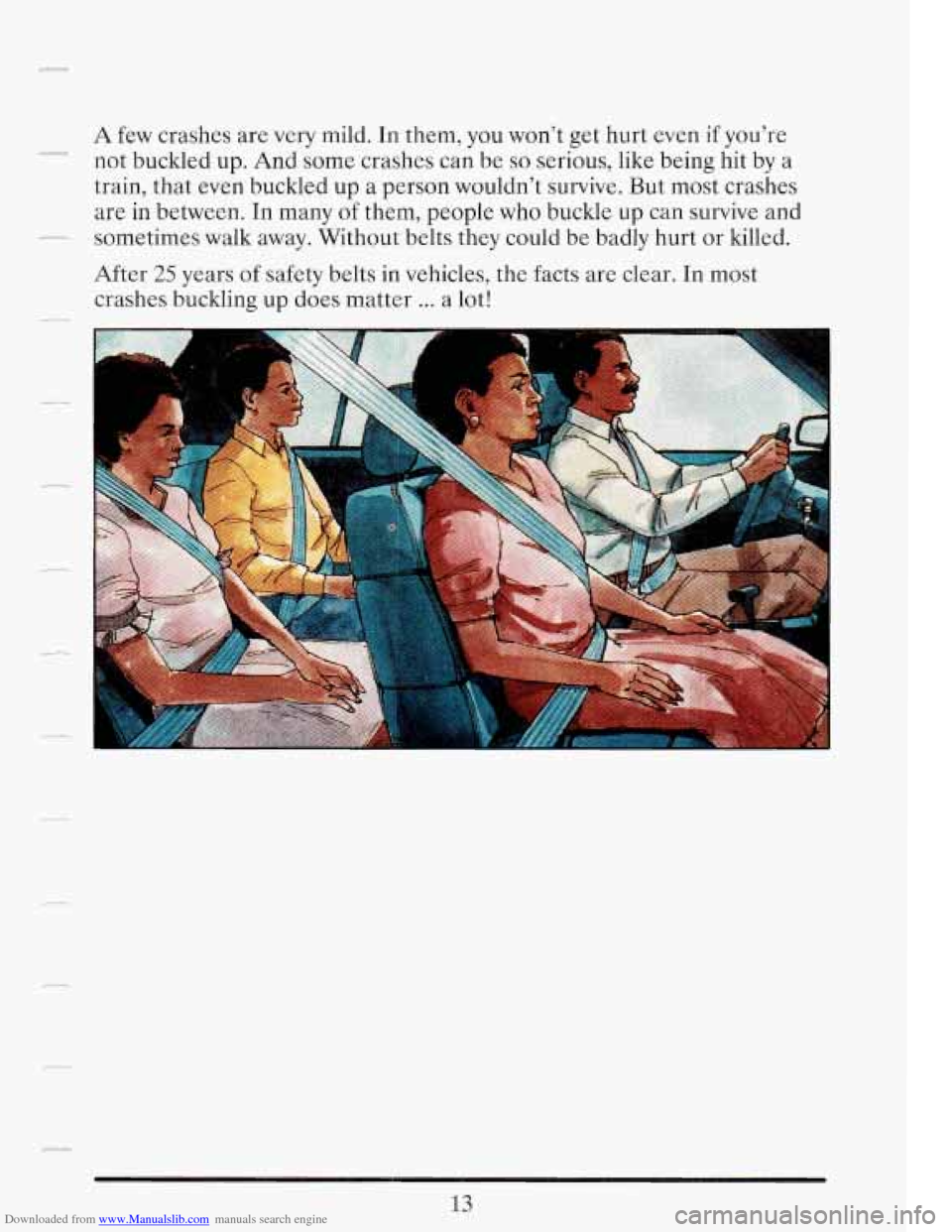
Downloaded from www.Manualslib.com manuals search engine A few crashes are very mild. In them, you won't get hurt even if you're
not buckled up. And some crashes can be
so serious, like being hit by a
train, that even buckled up
a person wouldn't survive. But most crashes
are in between.
In many of them, people who buckle up can survive and
-
- sometimes walk away. Without belts they could be badly hurt or killed.
After
25
crashes 1 --
years of
mckling safety belts
in vehicles, the facts are clear.
In most
up does matter
... a lot!
13
Page 28 of 386

Downloaded from www.Manualslib.com manuals search engine my Safety Belts Work
-
n
i
block, it stops. But the
child keeps
going!
14
Page 31 of 386

Downloaded from www.Manualslib.com manuals search engine or the instrument
panel
...
or the safety belts!
With safety belts, you slow down as the vehicle does.
You get more time
to stop. You stop over more distance, and your strongest bones take the
forces. That's why safety belts make such good sense. -
Page 32 of 386
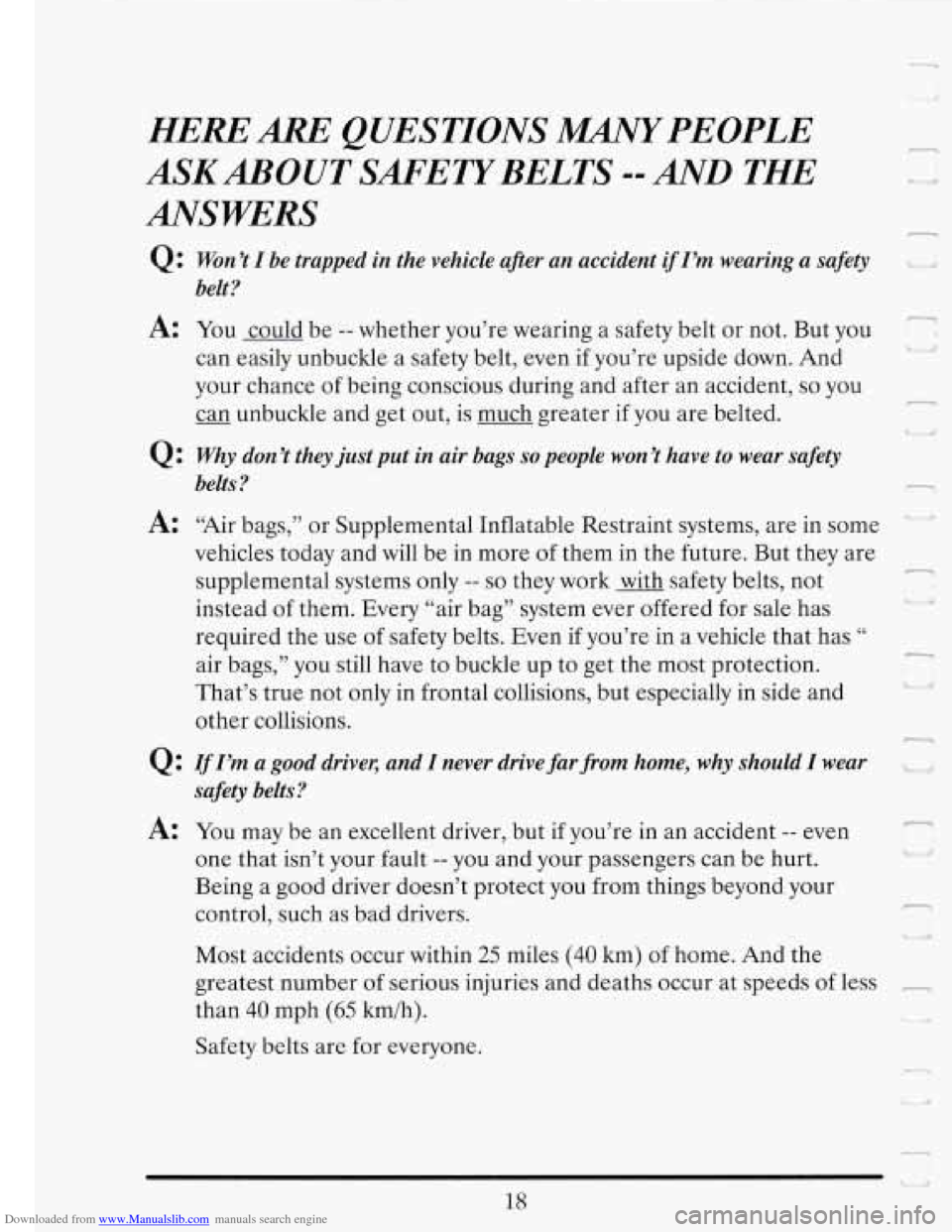
Downloaded from www.Manualslib.com manuals search engine HERE ARE QUESTIONS MANY PEOPLE
ANSWERS ASKABOUT SAFETYBELTS --AND THE
Q : Won ’t I be trapped in the vehicle afer an accident if I’m wearing a safety
A: You could be -- whether you’re wearing a safety belt or not. But you
belt?
can easily unbuckle a safety belt, even if you’re upside down. And
your chance of being conscious during and after an accident,
so you
can unbuckle and get out, is much greater if you are belted.
Q: why don’t they just put in air bags so people won’t have to wear safety
belts?
-
A: ‘Rir bags,” or Supplemental Inflatable Restraint systems, are in some 2:
rl iv
-1
n
U ..
-
1’. ’
jl L
n
vehicles today andwill be in more of them in the future. But they are
supplemental systems only
-- so they work with safety belts, not
instead of them.
Every “air bag” system ever offered for sale has
required the use of safety belts. Even if you’re in a vehicle that has
“
air bags,” you still have to buckle up to get the most protection.
That’s true not only in frontal collisions, but especially in side and
other collisions.
Q: IfI’m a good driver, and I never drive far from home, why should I wear
A: You may be an excellent driver, but if you’re in an accident -- even
one that isn’t your fault
-- you and your passengers can be hurt.
Being a good driver doesn’t protect you from things beyond your
control, such as bad drivers.
Most accidents occur within
25 miles (40 km) of home. And the
greatest number of serious injuries and deaths occur at speeds of less
than
40 mph (65 kmih).
Safety belts
are for everyone.
safety belts?
-1
T Iy
-1
?
-4
18